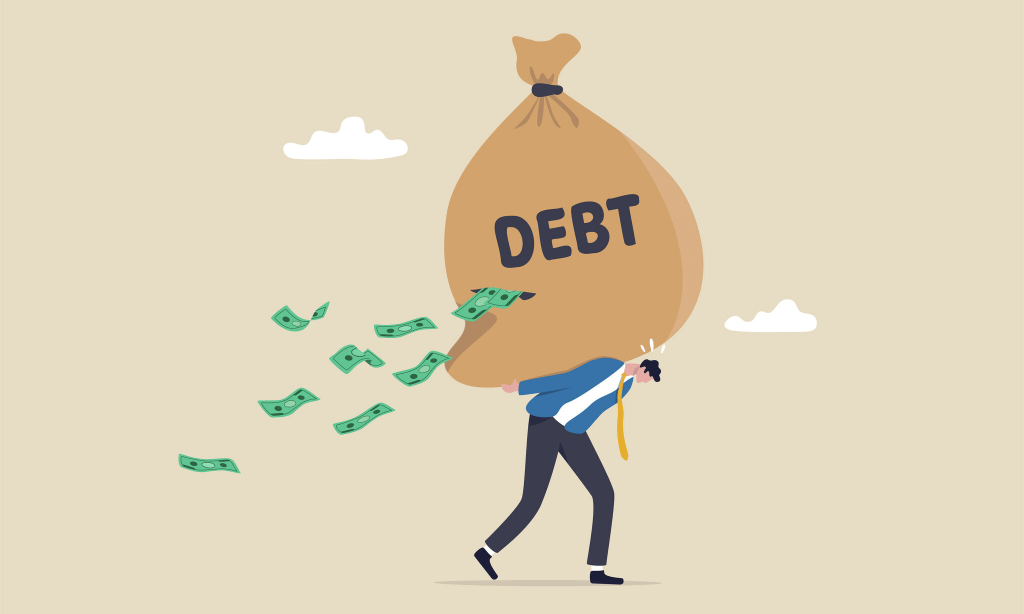In today’s fast-paced world, the concept of debt has become an integral part of our financial lives. At its core, debt is money borrowed with the promise of repayment, typically with interest. While the idea of owing money might seem frightening to many, not all debts are created equal. Some can be beneficial, acting as stepping stones towards achieving significant life goals, while others can become burdensome, leading to financial strain. In this post we will know what is good and bad debt.
The key to navigating the world of debt lies in understanding its two primary categories: good debt and bad debt. Recognising the difference between these two can be the difference between building a stable financial future and finding oneself in a cycle of never-ending repayments.
The Perception of Debt
Historically, debt has been viewed with a mix of necessity and caution. On one hand, it provides opportunities otherwise out of reach, such as homeownership or higher education. On the other, tales of spiralling credit card bills and unmanageable loan repayments serve as cautionary tales. The general sentiment towards debt is, therefore, one of respect; it’s a tool that, when used wisely, can be beneficial, but when mismanaged, can lead to financial ruin.
The recent COVID-19 pandemic has further complicated our relationship with debt. As businesses shuttered and jobs were lost, many turned to loans and credit to weather the storm. The impact of COVID-19 on debt accumulation has been profound. For some, it meant taking on more debt to manage daily expenses, while for others, it was about leveraging debt as a means to invest in opportunities during the economic downturn. This period highlighted the importance of understanding and managing debt, as its role in our lives became even more pronounced.
Defining Good Debt
Good debt, as the name suggests, is often seen as a beneficial form of debt. But what makes it “good”?
Characteristics of Good Debt:
- Investment in Future: Good debt often represents an investment that will grow in value or generate long-term income.
- Lower Interest Rates: Typically, good debts come with lower interest rates compared to bad debts.
- Tax Advantages: Some good debts offer tax deductions on the interest paid.
How Good Debt Can Enhance Financial Future: Taking on good debt can be a strategic move. It can provide opportunities for growth, increase one’s net worth over time, and potentially lead to a more prosperous financial future.
Examples of Good Debt:
- Mortgages:
- Benefits of Owning a Home: Homeownership offers stability, a sense of belonging, and the freedom to personalise one’s space.
- Appreciation of Property Value: Over time, real estate often appreciates, potentially increasing the owner’s net worth.
- Tax Advantages: Mortgage interest is often tax-deductible, reducing the effective interest rate.
- Student Loans:
- Investing in Education: An educated individual often has better job prospects, leading to higher earning potential.
- Potential for Higher Earning: Graduates typically earn more than non-graduates over their lifetime.
- Tax-Deductible Interest: The interest paid on student loans can often be deducted from taxable income.
- Home Equity Loans:
- Low-Interest Rates: These loans typically offer lower interest rates compared to other loan types.
- Potential Tax Advantages: The interest on home equity loans can be tax-deductible.
- Risks: Borrowers use their home as collateral, so there’s a risk of losing the home if they default on the loan.
- Small Business Loans:
- Entrepreneurship: Provides capital to start or expand a business.
- Potential for Significant Returns: A successful business can offer returns far exceeding the loan’s interest.
- Risks: Like all ventures, businesses come with inherent risks, including potential failure.
Defining Bad Debt

Bad debt, in contrast, doesn’t increase your wealth or have any lasting value. It often results from purchasing goods and services that quickly lose their value and do not generate long-term income.
Characteristics of Bad Debt:
- High-Interest Rates: Bad debts often come with exorbitant interest rates.
- Depreciating Assets: Money borrowed is often used to buy items that lose value over time.
How Bad Debt Can Hinder Financial Growth: Bad debt can quickly accumulate, leading to a cycle of debt that’s hard to break free from. It can strain personal finances, reduce credit scores, and limit future borrowing opportunities.
Examples of Bad Debt:
- Credit Cards:
- High-Interest Rates: Credit card debt often carries high-interest rates, making it expensive if not paid off promptly.
- Impact on Credit Score: Maintaining a high balance or missing payments can negatively affect one’s credit score.
- Potential for Accumulating Unmanageable Debt: With easy access to credit, it’s possible to accumulate more debt than one can handle.
- Payday Loans:
- Extremely High-Interest Rates: These short-term loans often come with interest rates that can be several times higher than credit card rates.
- Short-Term Solutions Leading to Long-Term Problems: While they might seem like a quick fix, they can lead to a cycle of debt if not paid back promptly.
- Automobile Loans:
- Depreciation of Vehicle Value: Cars lose value quickly, so you might end up owing more than the car is worth.
- Interest Rates: Depending on one’s credit score, auto loans can have high-interest rates.
- Loan Duration: Longer loan terms can lead to paying more in interest over the life of the loan.
Safe Debt Guidelines
Navigating the world of borrowing requires a keen understanding of when debt becomes too much. While taking on debt can be beneficial, it’s essential to ensure that it doesn’t become a burden.
Recommended Debt-to-Income Ratios:
The debt-to-income (DTI) ratio is a measure of an individual’s monthly debt payments relative to their monthly gross income. Financial experts often recommend a DTI ratio of 36% or lower, with no more than 28% of that debt dedicated to monthly mortgage payments. A lower DTI ratio indicates a better balance between debt and income.
Red Flags and Warning Signs:
- Minimum Payments: If you’re only making the minimum payments on your credit cards, it might indicate that your debts are too high.
- Declined Applications: Frequent rejections for credit or loans suggest that lenders view you as a high-risk borrower.
- Using Debt to Pay Off Debt: Relying on one credit card to pay off another is a clear sign of financial distress.
- Lack of Savings: If all your income goes towards servicing debt and you’re unable to save, it’s a warning sign.
- Losing Track of Debts: Not knowing how much you owe or to whom indicates a lack of financial control.
Managing Debt Wisely
Debt, when managed wisely, can be a tool for growth. However, mismanagement can lead to financial hardships.
Importance of Understanding Interest Rates:
Interest is the cost of borrowing money. Understanding interest rates is crucial as it directly impacts the total amount you’ll repay. A lower interest rate can save you significant amounts over the life of the loan. Always compare interest rates before borrowing and be wary of adjustable rates, which can increase over time.
Strategies for Paying Off Debt:
- Debt Snowball Method: Focus on paying off the smallest debt first while making minimum payments on larger ones. Once the smallest debt is cleared, move to the next smallest, creating a ‘snowball’ effect.
- Debt Avalanche Method: Prioritise debts with the highest interest rates, saving you money in the long run.
- Consolidation: Combine multiple debts into a single loan with a lower interest rate, making it easier to manage.
- Budgeting: Create a monthly budget, allocating a portion specifically for debt repayment.
- Negotiate with Lenders: Sometimes, lenders might be willing to offer better repayment terms or lower interest rates.
The Impact of Debt on Credit Scores and Future Borrowing Potential:
Your credit score is a reflection of your creditworthiness. High amounts of debt, especially bad debt, can lower your score. A lower credit score can lead to higher interest rates on future loans or even loan rejections. On the other hand, consistently making timely payments and reducing debt can boost your credit score, leading to better borrowing terms in the future.
Managing debt requires discipline, understanding, and a proactive approach. By recognising the signs of excessive debt and employing strategies to manage it, individuals can leverage debt as a tool for financial growth while avoiding its potential pitfalls.
Conclusion
In the intricate dance of financial management, debt plays a pivotal role. While it can open doors to opportunities, from homeownership to higher education, it also carries the potential to ensnare individuals in a cycle of repayment and financial strain. The distinction between good and bad debt is not just academic; it’s the difference between leveraging borrowed money for growth and being weighed down by mounting financial obligations.
Understanding the nuances of debt, from the intricacies of interest rates to the impact on one’s credit score, is essential. It empowers individuals to make informed decisions, ensuring that debt remains a tool for advancement rather than a shackle.
In today’s ever-evolving economic landscape, especially in the aftermath of global events like the COVID-19 pandemic, the importance of debt management has never been more pronounced. By adhering to safe debt guidelines, recognising warning signs, and employing effective repayment strategies, one can navigate the complexities of debt with confidence.
In the end, the goal is clear: to harness the power of debt for positive endeavours, ensuring a stable, prosperous financial future.
How does good debt help your credit?
Good debt, when managed properly, can positively impact your credit. Regular and timely payments on loans such as mortgages or student loans demonstrate responsible borrowing habits, which can boost your credit score.
What is bad debt?
Bad debt typically refers to debts taken on for purchases that quickly lose value and do not generate long-term income. High-interest credit card balances and payday loans are common examples of bad debt.
What is good debt?
Good debt is often seen as an investment in your future. It includes loans that have the potential to increase in value or generate income, such as mortgages, student loans, or business loans.
How to use good debt?
Good debt can be used as a tool for financial growth. For instance, taking a mortgage to buy a home can lead to property appreciation, or a student loan can lead to higher earning potential in the future. The key is to ensure timely repayments and manage the debt wisely.
When can good debt be bad?
Good debt can turn bad when it’s mismanaged. For example, taking on a mortgage or student loan that’s beyond one’s repayment capacity can lead to financial strain, missed payments, and credit score damage.
What are the characteristics of good and bad debt?
Good debt often has lower interest rates, offers potential tax advantages, and represents an investment in the future. Bad debt, on the other hand, usually comes with high-interest rates, is used for depreciating assets, and can quickly become unmanageable.
How does debt help credit score?
Debt, when managed responsibly, can help build a positive credit history. Consistent and timely payments on loans and credit cards show lenders that you’re a reliable borrower, which can improve your credit score.
What are the benefits of good debt?
Good debt can lead to financial growth, increase net worth, and provide opportunities otherwise out of reach. For instance, mortgages can lead to property appreciation, and student loans can result in higher future earnings.
How can bad debt damage your credit?
Bad debt, especially when left unchecked, can lead to missed payments, high credit utilisation, and collection actions, all of which can significantly lower your credit score. This can make future borrowing more expensive or even unattainable.

